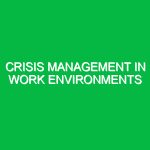The landscape of work has undergone a significant transformation in recent years. As companies explore more remote and isolated work sites—whether for oil drilling, mining, construction, or environmental research—the need for robust safety measures has never been more critical. Safety in Remote and Isolated Work Sites is not just an organizational responsibility; it is a vital element of the Health, Safety, and Environment (HSE) domain. This article delves into the various aspects of safety in these unique environments, highlighting risks, precautions, and regulatory frameworks that ensure the well-being of workers.
Understanding Safety in Remote and Isolated Work Sites
When we talk about remote and isolated work sites, we refer to locations that are often far removed from urban centers, medical facilities, and emergency services. These sites can range from offshore oil rigs to deep forest logging camps, and they pose unique challenges. The relevance of safety in these areas cannot be overstated. In remote locations, the potential for accidents and health emergencies is heightened due to limited access to immediate help, leading to a greater emphasis on proactive safety management.
Defining the Risks
Working in remote and isolated areas exposes employees to a variety of hazards. Understanding these risks is the first step toward effective safety management. Here are some of the primary hazards associated with such workplaces:
1. Environmental Hazards
From extreme weather conditions to wildlife encounters, environmental hazards can pose serious threats. For example, a worker at an isolated Arctic drilling site might face severe frostbite due to sub-zero temperatures, while an employee in a rainforest logging area could be at risk from poisonous snakes or insect bites. Understanding and adapting to the environment is crucial.
2. Equipment and Machinery Risks
Remote work often involves heavy machinery and specialized equipment. Malfunctions or improper use can lead to accidents. A case in point is a construction worker who suffered significant injuries when a crane malfunctioned at a remote site, resulting in a heavy load falling. Such incidents underscore the necessity of regular maintenance checks and operator training.
3. Psychological Strain
Isolation can take a toll on mental health. Workers may experience feelings of loneliness, anxiety, or depression, especially if they are away from family for extended periods. A study by the National Institute for Occupational Safety and Health (NIOSH) found that workers in isolated jobs reported higher levels of stress and lower job satisfaction. Addressing mental health is as crucial as physical safety.
4. Limited Emergency Response
In emergencies, the lack of immediate access to medical facilities can be life-threatening. A worker who sustains an injury in a remote site may face delays in receiving care, which could exacerbate the injury. This risk highlights the importance of having comprehensive emergency response plans tailored to the specific site.
Implementing Safety Precautions
To mitigate these hazards, organizations must adopt stringent safety precautions and best practices. Here are some actionable strategies:
1. Comprehensive Risk Assessments
Before commencing any project, conducting a detailed risk assessment is essential. This involves identifying potential hazards, evaluating the risks associated with them, and implementing control measures. For example, a mining company operating in a remote area should assess risks related to equipment use, environmental factors, and health hazards.
2. Training and Awareness Programs
Training is a cornerstone of safety in remote work environments. Regular training sessions ensure that workers are familiar with safety protocols, emergency procedures, and the proper use of equipment. For instance, a construction firm might require all employees to complete first aid training, ensuring that someone is always prepared to respond to injuries.
3. Use of Technology
Technology plays a vital role in enhancing safety. GPS tracking can help monitor worker locations, while drones can assess site conditions without putting personnel at risk. A notable example is the use of drones in surveying remote oil fields, which reduces the need for workers to traverse dangerous terrain.
4. Mental Health Support
Organizations should take proactive steps to support the mental health of their employees. Providing access to counseling services, creating opportunities for social interaction, and ensuring regular communication with family can help alleviate feelings of isolation. A remote team might set up weekly video calls to maintain connections, fostering a sense of community.
5. Emergency Preparedness Plans
Having an emergency response plan is critical for remote sites. This plan should detail procedures for various scenarios, including medical emergencies, natural disasters, and equipment failures. Regular drills can help ensure that everyone knows their roles during an emergency. For example, a remote research station might conduct fire drills to prepare for potential fire outbreaks.
Regulations and Standards Governing Safety
Various regulations and standards guide safety practices in remote and isolated work sites. Compliance with these regulations not only protects workers but also enhances organizational credibility. Key regulations include:
1. Occupational Safety and Health Administration (OSHA) Standards
In the United States, OSHA sets forth regulations that apply to remote work environments. These standards cover everything from equipment safety to personal protective equipment (PPE) requirements. Organizations must ensure compliance to avoid penalties and maintain a safe workplace.
2. International Standards Organization (ISO) Guidelines
ISO provides international standards for occupational health and safety management systems, specifically ISO 45001. This standard helps organizations identify and manage risks, improve safety performance, and enhance worker well-being. Adopting ISO standards can significantly improve safety practices.
3. National Institute for Occupational Safety and Health (NIOSH) Recommendations
NIOSH offers recommendations for protecting workers in remote settings. These guidelines focus on training, risk assessment, and mental health support, emphasizing a holistic approach to worker safety.
Real-Life Application of Safety Practices
Consider the case of an oil exploration company operating in a remote part of Alaska. After conducting a comprehensive risk assessment, they identified severe weather and the potential for equipment malfunctions as significant risks. They implemented robust training programs focused on emergency response and safety protocols. Additionally, they invested in advanced communication technology, allowing for instant contact with emergency services. As a result, the company reported a significant decrease in workplace incidents over the next two years, showcasing the effectiveness of proactive safety measures.
Conclusion
Safety in Remote and Isolated Work Sites is a multifaceted challenge that requires diligent attention and proactive measures. By understanding the unique risks associated with these environments and implementing comprehensive safety strategies, organizations can protect their workers and enhance overall workplace safety. As remote work continues to grow in various industries, prioritizing safety in these isolated settings will be paramount for both employee well-being and organizational success.


